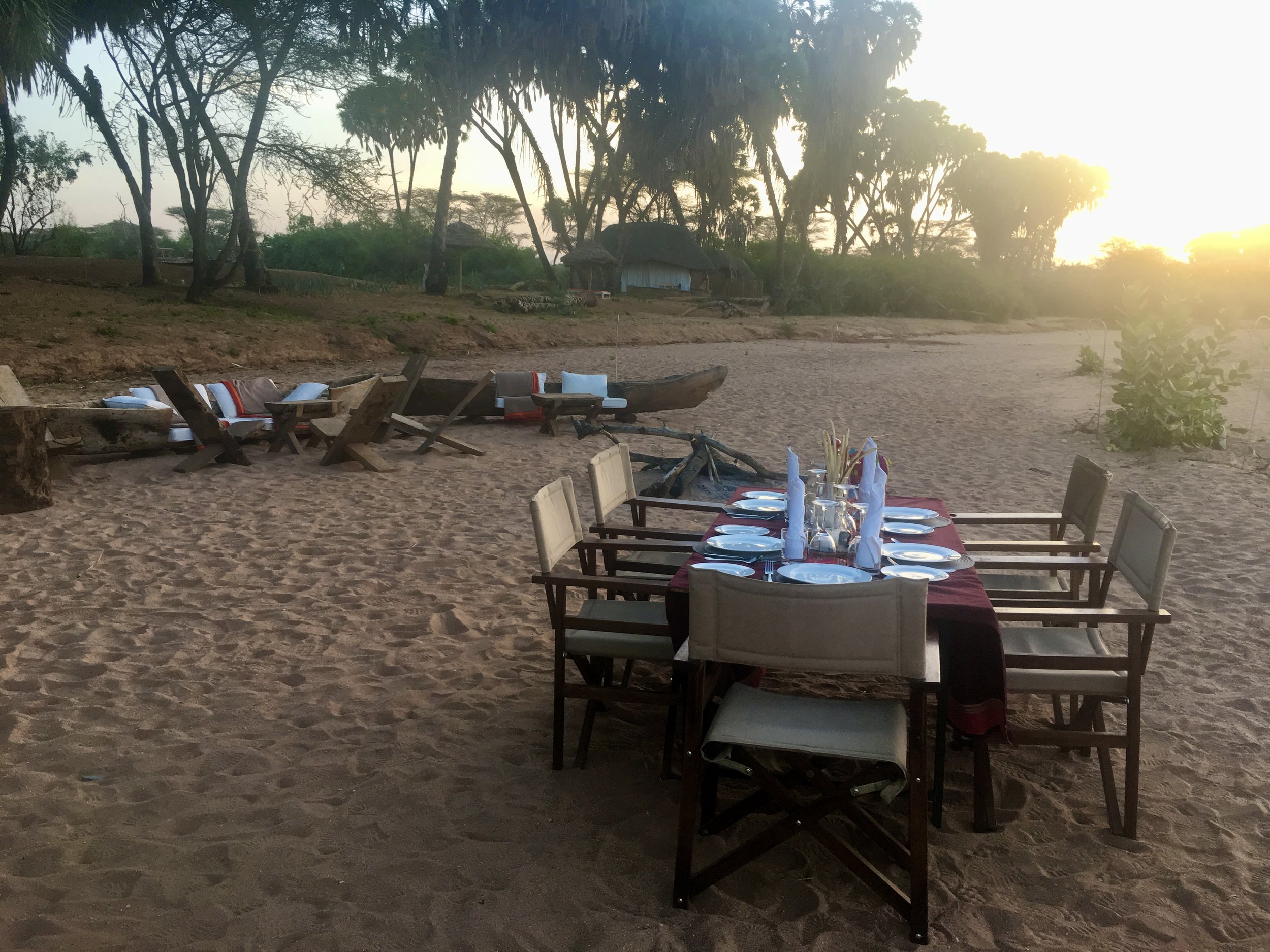A unique safari adventure in northern Kenya
Facing the prospect of an empty travel diary (shock horror), my lovely fella and I have been talking about where we might head off on holiday this year. With the memories of our incredible time in Costa Rica still fresh in our minds (and bank balance!) we won’t be doing a big trip this year.
But we were recalling some of the other magical adventures we’ve had together over the years, so I thought I’d share one of them with you. A truly spectacular and unforgettable safari in northern Kenya, which included the most thrilling animal encounter I’ve ever experienced.
This is how it happened:
On the instructions of the ranger, we had abandoned our jeep and were walking in careful, silent single file through the bush. After 10 minutes, he signalled us to clamber up the rocky escarpment ahead of us.
We heard the rhino before we saw her. Her lumbering gait cracking the dried branches and grasses underfoot, and her insistent munching of the woody acacia and thorn trees growing ever louder as she ambled towards where were standing. Eventually she came to a halt in the dense undergrowth, so close to our elevated position that we could clearly see her blinking.
Rhinos are renowned for their poor eyesight, which they compensate for with with an acute sense of hearing and smell, and for their tendency to charge at anything they perceive as a threat. Black rhinos, like the female in front of us, are more agile than their white counterparts. Even though we were separated by the thicket and the boulders we were standing on, I was convinced she must have been able to hear how loudly my heart was hammering with excitement and awe. But although she appeared to look directly up at us, she remained apparently, and thankfully, unaware of our presence, and eventually manoeuvred out of the undergrowth and set off in search of fresh feeding pastures.
Can you spot the rhino?
I’ve holidayed in Kenya three times over the years, and done all manner of different safaris. The walking black rhino tracking experience, the first in East Africa, offered by Saruni Rhino, in the northern Sera Community Conservancy, promised an animal encounter like no other. And that’s certainly what it delivered. In spades.
We had arrived from Nairobi in a well-worn workhorse of the safari skies - a 12-seater turboprop Cessna, having been instructed not to disembark at the first dirt airstrip as that wasn’t our stop! We were met and driven the two hours to the Saruni Rhino lodge by two local Samburu tribesmen, dressed in their colourful, traditional shukkas, and beaded jewellery. Camp manager Sammy and guide Joseph would become very familiar to us over the next four days, two spent at at Rhino and two at its sister lodge, the spectacular Saruni Samburu (of which more later).
With one of the Saruni Rhino staff team in his colourful traditional dress
Saruni Rhino is a collection of 4 bandas - open stone cottages with thatched roofs - built under huge swaying palm trees alongside a dried river bed. The main banda houses a communal dining table, sofas and chairs, but meals are mostly taken outside. The camp is positioned alongside a popular watering hole, where we watched innumerable vultures and a variety of other wildlife including oryx, zebra and elephant come to drink.
Our bedroom at Saruni Rhino
One or two of the friendly staff team sit with you at mealtimes, giving a fascinating opportunity to find out about about their way of life, tribal heritage and customs. In the evening, after sundowners sipped as you sit in seats made of dug-out canoes, under a sky bursting with stars, your meal is served alongside a blazing campfire.
Ready for the evening meal at Saruni Rhino
But the real business of Saruni (the word means sanctuary in the Samburu language) Rhino, as its name suggests, is all about the magnificent black rhino and their preservation and breeding.
There are only 4000 black rhinos left in the world. The Sera Community Conservancy, 54,000 hectares of fenced-in bush, is home to 19 of them plus a number of new calfs, born since the conservation programme, one of the most advanced in the world, was introduced in 2015. Each adult rhino has a chip in its horn, enabling the 100 rangers - 50 during the day and 50 each night - to track and check on them, and to ensure their safety and protection.
A much clearer shot of one of Saruni’s carefully protected rhinos
When the small and carefully managed groups like ours - there were three of us, a guide and an armed guard - go into the conservancy, which only happens under strict controls, you are joining the rangers as they go about their daily duty of monitoring the whereabouts of the rhinos, rather than taking part in an activity staged for the benefit of tourists.
More than that, the local community also benefit from the conservation programme and the presence of the tourists. The camp’s bandas are built and owned by the Samburus and the Saruni company rents them from them. The staff teams at the camp, the guides and the rangers in the conservancy are all locals and are offered training and employment in an area where precious few other opportunities exist.
Nice spot for a spot of breakfast
We went into the conservancy four times during our stay - each early morning and late afternoon, giving us time to rest and relax during the hottest hours of the day. The two morning drives included a welcome, tasty breakfast magically produced from a sturdy picnic hamper in the boot of the open-sided jeep. Our thrilling rhino sightings included close up viewings of another of the females along with her 3 month old calf, and two appearances by the huge daddy of the males, affectionately known as Cedric the Mighty by the rangers, who explained that each of the rhinos has its own characteristics and personality. Cedric is apparently notoriously grumpy.
The oldest rhino in the conservancy is one of the mothers, but unusually she abandoned her calf who was taken to an orphanage and will be returned to the park when he is 10 months old. The rhinos, who are naturally shy and solitary unless they’re breeding, live to approximately forty and females can have 5 to 6 calves in a lifetime.
The conservancy is also home to a wide variety of other animals including reticulated giraffe, zebra, elephants, cheetah, impala, eland, buffalo, and gazelle as well as a plethora of birds, amongst them the wonderfully named go-away birds who warn the animals of approaching danger. The drives and walks give you the opportunity to see plenty of them as well.
The main lodge and one of the two swimming pools at Saruni Samburu
If the experiences at Saruni Rhino are intimate and thrilling, 2 hours drive through the bush brings you to sister camp Saruni Samburu where spectacular and expansive are the order of the day. For a start there’s its position. Built (how?) sprawling over the top of one of the peaks of the Kalama Mountains, its large open sided lounge and dining area, six eco-villas and two infinity pools overlook the vast Kalama Wildlife Conservancy, ringed with mountains, including snow-covered Mount Kenya, in the far distance. Directly below the lodge is a man-made watering hole, where it’s possible to sit in the specially constructed hide and watch the animals coming to drink.
The view across some of the rooms at Saruni Samburu of the Kalama Wildlife Conservancy
Kalama is home to a large concentration of elephants and we were treated to the sight of a magnificent bull making it’s stately, solitary way across the bush, as we settled into our fabulous villa complete with an outdoor shower - one of my favourite things - on the terrace. Talk about washing with a sensational panorama as a background, I never used the shower in the bathroom once. It comes as no surprise to discover that one of the rooms here has been voted as having the best view in Africa.
We did a couple of game drives during our two days at Samburu - again in the early morning and late afternoon - and saw a wonderful range of animals, including a cheetah stalking a herd of gazelles (it didn’t pounce, at least not whilst we were watching), a playful family of elephants (one decided our jeep needed close-up inspection), elegant gerenux, local to only this part of Kenya, Somali ostrich, lots of warthogs (referred to as pumbaas) and more birds than you could shake a pair of binoculars at. All expertly identified and explained by our knowledgable Samburu guides/drivers. My favourite fact: warthogs have such terrible memories that although they run when they sense danger, they quickly forget why they’re running, so they stop, making them comically easy prey.
Some of the Saruni animals
We chose to spend our final afternoon in rather different ways. Fascinated by a near-by peak topped with a rock looking eerily like a gorilla’s head, my other half decided he wanted to climb up for a closer look. Our faithful guide Joseph assured him it wasn’t a difficult assent, so they set off accompanied by a couple of the other guides (one armed in case any animals decided they fancied joining in), whilst I took advantage of the onsite spa and had an expert massage then lay by and swam in the sinuously shaped infinity pool, revelling in the 360 degree panoramic view.
Spectacular pool with a spectacular view
A couple of hours after he set off, my other half returned exhausted and sweaty (Joseph may have been a little economical with the truth about the climb) but exhilarated.
As we drank our sundowners looking out over the spectacular vastness of the Kenyan plains and the star saturated skies, we reflected on a magical few days in this most special part of this most special country
Sunset putting on a show at Saruni Samburu
Find out more about Saruni Rhino HERE
And Saruni Samburu HERE
Other far-flung travel posts you’ll enjoy















